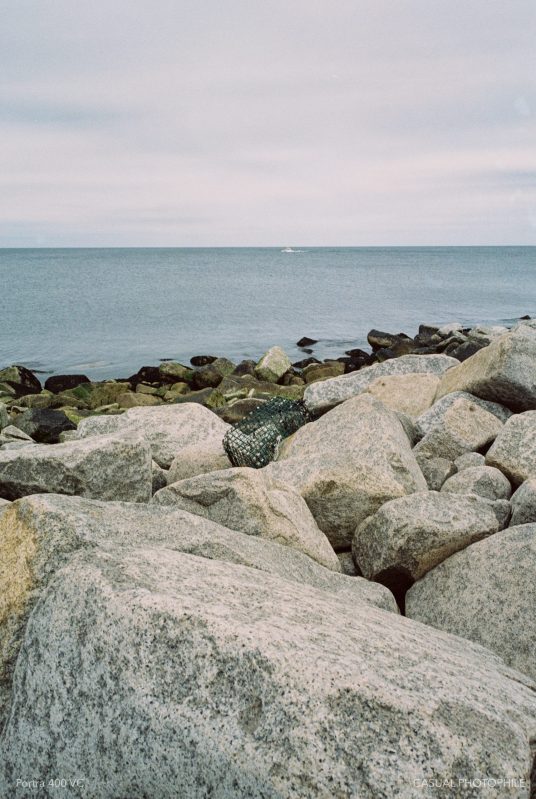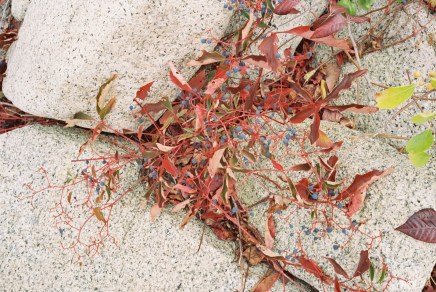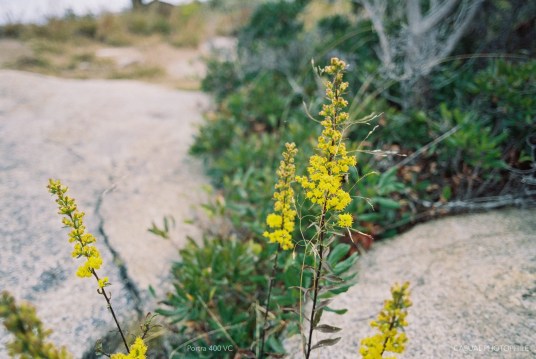I live my life reminiscing about a past I never had. I fantasize about drinking apricot cocktails with Jean-Paul Sartre in Montparnasse or a glass of kirsch in Frankfurt’s Westend Süd with Theodor Adorno and Max Horkheimer. Like many who pine for days they did not live, I surround myself with residue of bygone eras that I take to be talismans aligning me with those times. An old Marantz receiver, an older Mido watch, old books, and, yes, old cameras.
Sometimes when I go out to shoot, I imagine myself transported to the past. There I am, on some drumlin peninsula on the New England coast, wearing New Balance sneakers, probably some logo-less t-shirt, and jeans. My clothing is not really vintage, but I can pretend, right? Especially because I’m shooting with a camera that actually is decades old.
I like to imagine that I’m breathing the air in 1995, when I had no idea what Kyocera was or that their newly released Contax G1 would go on to multiple year-end awards. In my imagination, I am outside shooting with a top-of-the-line, brand new camera. Social media doesn’t exist, the Internet is used by 0.7% of the world’s population, and, best of all, everyone’s still shooting film. Decades later, many films have died, and the two dead films I’m shooting this day are Kodak Portra 400 VC and Kodak Portra 160 NC.
Kodak released their first Portra films in 1999 to accompany their Pro (including Vericolor) and Gold lines. At first, Portra included speeds of 160 and 400 in two variations: Vivid Color (VC) and Natural Color (NC). Later they would release an 800 speed Portra and a C-41 B&W Portra. And then, to make decisions harder, Kodak introduced the Ultra Color (UC) film in ISOs of 100 and 400. UC was not a Portra film but was intended to be more saturated than the VC formulation of Portra.
Today’s new, first-time film users will not have experienced the golden years of Kodak Portra. The Portras produced today are stellar, probably the best Portra ever made in terms of quality, and equally stellar at any speed (there are 160, 400, and 800 ISO versions). Having three speeds of one of history’s most beautiful film stocks is still pretty killer. But variety is the spice, they say, and sadly the days of having access to a range of Portras that vary beyond just ISO are gone, unless you pick up some expired rolls. When James told me that he had a few rolls of these extinct films up for grabs, I snapped at the opportunity to shoot them.
I first loaded up the 400 VC, set my ISO to 100 (I didn’t know the expiration date, so I figured two stops of overexposure to be safe) and set out for a state park on the North Shore.
The North Shore of Massachusetts is rockier than the South Shore and the Cape, and I particularly love it for these rocky coasts. To see these massive boulders strewn together as if some kid had spilled a tub of blocks is overwhelming. Who knows how far in the past geologic forces created the landscape at which I’m now looking? Certainly well before 1995. Wikipedia says the granite here is 440 million years old. The fact that I’m there among crags created half a billion years ago is kind of nuts to me.
The day is overcast but that just makes for moodier photos of the coasts, the sea, and the accompanying mountain vegetation that grows there. The flora is marvelous. Even in late October, there are these little asters and goldenrods that sprout up out of the crevasses and grit and sand of the place.
A particular tree catches my attention. Not knowing much of anything about trees, but nonetheless a great admirer, I tried to find out something about the tree in retrospect. It might be a limber pine (pinus flexilis) or maybe it’s a pitch pine (pinus rigida). These guesses seem contradictory, but, again, this isn’t my forte. The tree is Seussian and I love it.

As always, shooting with film is a deliberate process. I’m not seeing my shots, I only have a few dozen frames to work with, and I’m never shooting in Program. My G1 does the focusing for me, but I have the Portra 160 NC in my Voigtländer Bessa R2 and that camera is fully manual. I’ve metered at ISO 50, to again compensate for the cruel degradation of time on my expired film.
As I clamber and crouch around the coast and the old quarry behind, I’m lost in time. What matters in those moments is framing the world within my viewfinder. In a poem by Wendell Berry called Sabbaths 2001: VI, Berry talks about a singing wren “who thinks he’s alive / forever, this instant, and may be.” In these moments on the Cape Ann coast, I, my camera, and my film are all twenty-something years old. The mallards, the sparrows, and the sandpipers are only a few years old. The asters are even younger and soon they’ll be gone. But together then we might as well be alive forever.
The results from the early-2000s Portra are to be expected. The VC looks a bit grainier than Portras of today, and the colors are, interestingly, more subdued. The NC, which I also shot while walking around Cambridge with my friend Jess, needs some help in post processing – its contrast and the black point dropped down with the white point brought up – but overall it performs pretty well.
In the end, between the two rolls, I have many keepers, but many more throwaways. The shots that work really work. But most of the frames are just too noisy and too flat to be worth it.
Some of that comes down to my personal style, which favors punchier contrast and color rendition. Frankly, some of the VC photos fit the mainstream profile of that sort of lonely, grungy, faded look that’s associated in some circles with shooting film. It fits, because this film is old and produced photos that look old.
When I fantasize about being an adult in 1995 when Contax was still around and digital photography hadn’t yet become the de facto image recording medium it was destined to be, I often wonder why so many of the 35mm film photos produced back then look so atrocious. After all, I’m using cameras that were made back then, and shooting film that was for the most part available then, if not identical in quality. So why do the photos in my parents’ photo albums look so different from my own prized photos taken on film today?
Part of it was the fact that my relatives were likely using inexpensive point-and-shoots rather than top-of-the-line cameras of the day, the Contax G1 or even a respectable SLR from Olympus, for instance. Another factor is probably the development and scanning. I remember dropping off rolls of film at Rite-Aid with my dad and while the labs there may have been technologically fine, the care given to the process was probably not equal to the care given by specialty labs operating today – the one I use is Northeast Photographic. And then, of course, maybe the photos were taken without ideal settings and conditions—a lot of the photos I look back on are underexposed.
But today, the vast majority of the over one-trillion photos taken every year are taken using a smartphone. And thanks to exponential technological advancement, the software and hardware at play in a modern smartphone is pretty damn good. Someone may dispute this—especially after seeing their parents’ highly-edited, 5x-digital-zoomed Instagram shots—but it’s really not that difficult to produce a beautiful image in 2020.
Shooting expired film is a small accoutrement of the pretend-it’s-thirty-years-ago photography make-believe game. But in the end, if you prefer the photos you make on brand new Fujifilm Provia 100F to the photos you make on expired film, then is it worth it?
Today when I went out to shoot for a few hours, some young kids were using their phones to record TikToks on the gorgeous and awe-inspiring Cape Ann cliffs. This is about the least old-fashioned thing you could be doing at a nature preserve. My first inclination was to laugh a bit inside and I even said to my wife, “Why hike a mile into a State Park only to prop your phone up and do choreographed TikToks?”
In retrospect, I resent my ever-so-slight disdain. It didn’t really matter, and it didn’t ruin the illusion for me. When I sat down, nestled against a rock wall, listening to the waves crash, holding my camera (loaded with fresh film), I was outside of time. It wasn’t 1995 and it wasn’t 2020, it just was.
Buy film from F Stop Cameras or Subscribe to our Film of the Month Club
Follow Casual Photophile on Facebook and Instagram
[Some of the links in this article will direct users to our affiliates at B&H Photo, Amazon, and eBay. By purchasing anything using these links, Casual Photophile may receive a small commission at no additional charge to you. This helps Casual Photophile produce the content we produce. Many thanks for your support.]





















You might equally argue that film and TikTok are equally insignificant blips in the (pre)history of a landscape — but that both, in their way, encourage people to appreciate it and to keep it wild.
As one who was an adult in 1995 (though not in 1885 as my fat finger tried to make it) a G1 still seems pretty modern to me — as does almost anything without a film-advance lever.